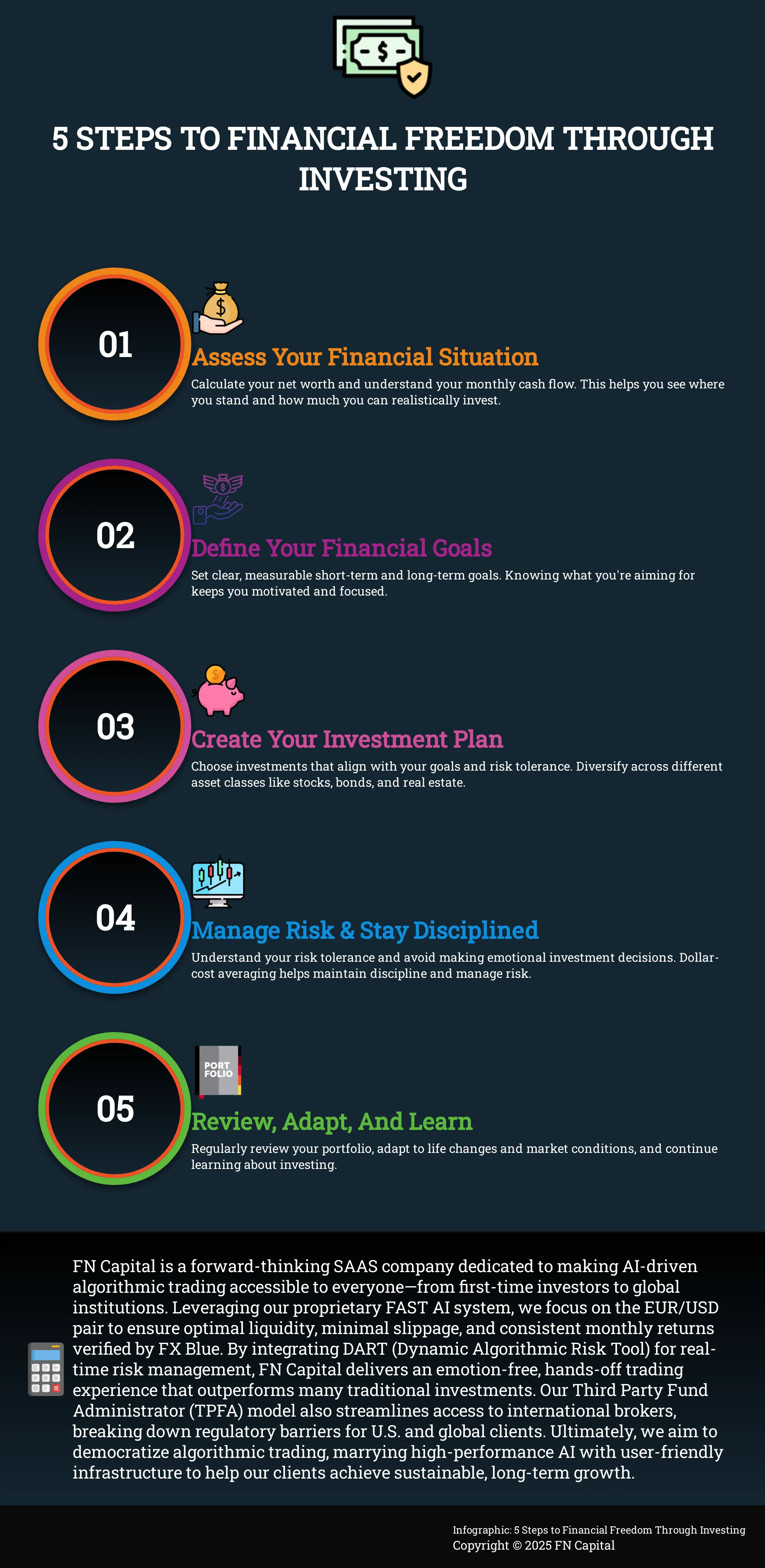Financial freedom—that elusive state where money worries fade into the background and you have the resources to live life on your own terms. It’s a goal many aspire to, but often feel unsure how to reach. The good news is, achieving financial freedom through investing is within your grasp, no matter your starting point. This comprehensive guide provides a practical, step-by-step approach to building wealth and securing your financial future. We’ll explore a range of investment options suitable for beginners, from stocks and bonds to real estate and alternative investments. You’ll learn how to create a personalized investment plan, manage risk effectively, and overcome common investing hurdles. Get ready to take control of your finances and embark on the exciting journey toward financial freedom.
Key Takeaways
- Financial freedom is built through smart investing habits: Create a personalized plan, diversify your investments, and focus on long-term growth through passive income and compounding. Regular contributions, even small ones, make a big difference over time.
- Multiple investment options are available for everyone: Explore stocks, bonds, index funds, REITs, and alternative investments. Utilize robo-advisors, investment apps, and online resources to simplify the process and manage risk effectively.
- Regularly review and adapt your investment approach: Track your net worth, evaluate your passive income streams, and adjust your goals as needed. Stay informed about market trends and continue learning to make sound investment decisions.
What is Financial Freedom and Why Does It Matter?
Financial freedom means having enough income from savings and investments to live the life you want, without needing a traditional job. It’s about taking control of your finances and making your own choices, whether that’s early retirement, starting a business, or simply having the flexibility to pursue your passions. It’s less about being rich and more about having the resources to live comfortably and pursue your goals. Financial security and personal satisfaction are at its core. For many, it’s about reducing financial stress and having the freedom to spend time on what truly matters, like family, travel, hobbies, or giving back to the community.
Achieving this state doesn’t happen overnight. It’s a journey built on consistent financial habits, not get-rich-quick schemes. Regardless of your income, managing your money wisely and living below your means is crucial. It requires discipline and a shift in mindset. True wealth isn’t defined by a specific number in your bank account, but rather a state of mind where your lifestyle choices align with your values and long-term goals. Financial freedom is a fluid concept, adapting to your evolving life and aspirations.
How Investing Builds Financial Freedom
Investing is a powerful tool that can pave the way to financial freedom, giving you more control over your finances and future. It’s about building a life where your money works for you, rather than the other way around. This section explores two key ways investing helps you achieve this: generating passive income and growing your wealth through compounding.
Generate Passive Income
Financial freedom means having enough income from savings and investments to live the life you want, without needing a traditional job. It’s about making your own choices and having the flexibility to pursue your passions. Generating passive income is a core component of this. Passive income means earning money without actively working for it. Investments like dividend-paying stocks, rental properties, or even peer-to-peer lending can create streams of passive income that supplement or even replace your regular earnings. This consistent income flow can provide a safety net, allowing you to weather unexpected expenses or pursue opportunities without financial constraints. Building multiple passive income streams diversifies your income sources and strengthens your overall financial security.
Grow Wealth Through Compounding
Compounding is the snowball effect of investing, where your returns generate even more returns over time. Think of it as earning interest on your interest. It’s a key factor in building long-term wealth. The earlier you start investing, the more time you have to benefit from this powerful force. Even small, regular contributions can grow significantly over decades thanks to compounding. One practical investment strategy focuses heavily on stocks during the wealth-building phase, using low-cost index funds to capture market growth. As experts suggest, starting early and remaining consistent are crucial for harnessing the power of compound interest and achieving financial freedom.
Investment Options for Beginners
Getting started with investing can feel overwhelming, but it doesn’t have to be. Several accessible options are perfect for new investors. Let’s explore a few:
Stocks, Bonds, and Index Funds
Investing in stocks, bonds, and index funds is a foundational strategy for beginners. Stocks represent ownership in a company and offer the potential for high returns, but they also come with higher risk. Bonds, essentially loans to governments or corporations, provide more stability and generate income through interest payments. A good way to balance risk and reward is with index funds. These funds track a specific market index (like the S&P 500), giving you instant diversification and typically lower fees. As a new investor, understanding the inherent risks within each investment type is crucial for making sound decisions. For example, new investors often struggle with assessing and mitigating hidden risks in various investment strategies.
Real Estate and REITs
Real estate has long been a popular wealth-building tool, but buying property directly requires significant capital and comes with ongoing management responsibilities. A more beginner-friendly approach is investing in Real Estate Investment Trusts (REITs). REITs allow you to invest in real estate without the hassle of property ownership, offering liquidity and often providing regular income through dividends. They’re also a great way to diversify your investment portfolio beyond stocks and bonds. REITs can be an excellent option for beginners looking to enter the real estate market without the complexities of direct property ownership, offering both liquidity and regular income.
Alternative Investments
Beyond the traditional options, there’s a world of alternative investments. These can include commodities (like gold or oil), hedge funds, private equity, and more. While alternatives can offer diversification and potentially higher returns, they often come with unique risks and complexities. It’s essential for beginners to approach these options with caution, conduct thorough research, and potentially seek advice from a financial advisor before diving in. Investing in alternative assets can be a way to hedge against market volatility, but it is essential for beginners to understand the complexities and risks involved.
Essential Investing Strategies
Smart investing isn’t about chasing the latest trends. It’s about building a solid foundation for long-term financial growth. These core strategies can help you achieve your financial goals:
Diversify Across Asset Classes
Don’t put all your eggs in one basket. Diversifying your investments across different asset classes—like stocks, bonds, and real estate—is key. This strategy helps balance your portfolio and reduce the impact of any single investment underperforming. As Forbes explains in their article on financial success, diversification mitigates risk by spreading your investments, making it a smart move for both long-term investors and those more actively trading.
Dollar-Cost Average and Invest Consistently
Consistency is key when it comes to investing. Dollar-cost averaging helps you automate your investments with regular contributions, regardless of market fluctuations. This disciplined approach not only helps manage risk but also encourages consistent investing habits, which, over time, can lead to better returns.
Think Long-Term and Leverage Compound Interest
Essential Investing Strategies
Smart investing isn’t about chasing the latest trends. It’s about building a solid foundation for long-term financial growth. These core strategies can help you achieve your financial goals:
Diversify Across Asset Classes
Don’t put all your eggs in one basket. Diversifying your investments across different asset classes—like stocks, bonds, and real estate—is key. This strategy helps balance your portfolio and reduce the impact of any single investment underperforming. As Forbes explains in their article on financial success, diversification mitigates risk by spreading your investments, making it a smart move for both long-term investors and those more actively trading.
Dollar-Cost Average and Invest Consistently
Consistency is key when it comes to investing. Dollar-cost averaging helps you automate your investments with regular contributions, regardless of market fluctuations. This disciplined approach not only helps manage risk but also encourages consistent investing habits, which, over time, can lead to better returns.
Think Long-Term and Leverage Compound Interest
Time is your greatest ally in investing. Starting early and maintaining a long-term perspective allows you to harness the power of compound interest, where your earnings generate even more earnings over time. Even small, regular investments can grow significantly over the long haul. This Investopedia article highlights how compounding makes early and consistent investing a cornerstone of building long-term wealth.
Investing always involves some level of risk. Understanding your risk tolerance—how much potential loss you’re comfortable with—is essential for making informed investment decisions. One of the biggest pitfalls for new investors is letting emotions influence their choices. Market fluctuations are normal, and reacting impulsively can lead to losses. Learn about different asset classes and their associated risks. Diversification is a key strategy for managing risk, as it spreads your investments, reducing the impact of any single investment’s performance. Don’t hesitate to seek guidance if you’re unsure about how to assess the risks involved in different investment strategies.
Overcome Common Investing Hurdles
Getting started with investing can feel overwhelming, but understanding the common pitfalls can make the journey smoother. Let’s break down some hurdles and how to overcome them.
Manage Emotions in Volatile Markets
Investing isn’t a straight line to riches. Market fluctuations are inevitable, and watching your portfolio value dip can be unsettling. New investors sometimes make emotional decisions, buying high on excitement and selling low out of fear. This is a surefire way to lose money. Instead, take a deep breath and remember your long-term goals. Consider a long-term strategy to avoid impulsive reactions. Market downturns can actually present buying opportunities if you stick to your plan.
Avoid Common Investment Mistakes
Create Your Personalized Investment Plan
A personalized investment plan acts as your roadmap to financial freedom. It considers your current financial health, your goals, and your comfort level with risk. Building this plan isn’t a one-time activity; it’s an ongoing process that evolves with you.
Assess Your Financial Situation
Before you start investing, take stock of your current financial standing. Calculate your net worth by subtracting your liabilities (debts like student loans or credit card balances) from your assets (what you own, like savings, property, or investments). Understanding your cash flow—how much money comes in and goes out each month—is also key. This assessment helps you determine how much you can realistically invest and what kind of return you’ll need. As a new investor, it’s important to establish these financial habits to avoid common investing mistakes.
Set Achievable Goals
What does financial freedom mean to you? Is it early retirement, the ability to travel, or simply having a financial cushion for unexpected expenses? Defining your goals, both short-term and long-term, is crucial. Make sure your goals are specific and measurable. Instead of aiming for “more money,” set a target amount. Prioritize your goals and break them down into smaller, actionable steps. Remember, financial independence often involves making choices about your spending and playing the long game.

Understand and Manage Risk
Investing always involves some level of risk. Understanding your risk tolerance—how much potential loss you’re comfortable with—is essential for making informed investment decisions. One of the biggest pitfalls for new investors is letting emotions influence their choices. Market fluctuations are normal, and reacting impulsively can lead to losses. Learn about different asset classes and their associated risks. Diversification is a key strategy for managing risk, as it spreads your investments, reducing the impact of any single investment’s performance. Don’t hesitate to seek guidance if you’re unsure about how to assess the risks involved in different investment strategies.
Life throws curveballs, and markets shift. Major life events—marriage, a new baby, a career change—often require adjustments to your financial plan and investment strategy. Similarly, market conditions can change due to economic factors, geopolitical events, or emerging technologies. Being prepared to adapt is essential. Remember, investing is a marathon, not a sprint. Building wealth takes time, strategy, and persistence. Stay informed about market trends and be ready to adjust your portfolio accordingly. This might involve reallocating assets, exploring new investment opportunities, or revisiting your risk tolerance.
Continue Your Financial Education
The financial world is constantly evolving. Continuing your financial education is crucial for staying ahead of the curve. Regularly read financial news, stay updated on tax laws, and explore new investment strategies. Understanding the fundamentals of investing is just the beginning. As you gain experience, delve deeper into specific investment areas that interest you. Consider taking online courses, attending webinars, or reading books by respected financial experts. The more you learn, the better equipped you’ll be to make informed investment decisions and achieve your financial goals.
Leverage Tools and Resources for Investors
Overcome Common Investing Hurdles
Getting started with investing can feel overwhelming, but understanding the common pitfalls can make the journey smoother. Let’s break down some hurdles and how to overcome them.
Manage Emotions in Volatile Markets
Investing isn’t a straight line to riches. Market fluctuations are inevitable, and watching your portfolio value dip can be unsettling. New investors sometimes make emotional decisions, buying high on excitement and selling low out of fear. This is a surefire way to lose money. Instead, take a deep breath and remember your long-term goals. Consider a long-term strategy to avoid impulsive reactions. Market downturns can actually present buying opportunities if you stick to your plan.
Avoid Common Investment Mistakes
As a new investor, it’s easy to get caught up in the excitement and make impulsive decisions. Common mistakes include chasing hot tips, neglecting to research investments, and concentrating your investments too heavily in one area. Nasdaq highlights the importance of avoiding these pitfalls. Thoroughly research any potential investment and diversify your portfolio to spread risk. A well-diversified portfolio can help cushion the blow if one investment underperforms.
Maintain Investment Discipline
Building wealth through investing takes time and discipline. It’s a marathon, not a sprint. Wealth Twins emphasizes the importance of sticking to basic investing principles. Create a plan and stick to it, even when markets get bumpy. Regularly contributing to your investments, even small amounts, can make a big difference over time thanks to the power of compounding. Remember, consistency is key to reaching your financial goals.
Evaluate Passive Income Streams
Building diverse passive income streams is crucial for financial stability and accelerating your journey toward financial freedom. There are two primary paths to financial freedom: consistent income from a business or investments, or having substantial assets like property or stocks that you can tap into when needed. Are you exploring dividend-paying stocks? Rental properties? An online business? Regularly evaluate the performance of these income streams. Are they generating the returns you expected? Are there areas for improvement or diversification? Explore various passive income ideas to diversify your income streams.
Adjust Your Financial Goals
Life rarely goes exactly as planned, and your financial goals should be flexible enough to adapt to change. Defining short-term and long-term financial goals with specific amounts and deadlines is crucial for staying focused and motivated. However, it’s equally important to revisit and adjust these goals periodically. Did you get a raise? Experience an unexpected expense? Your goals should reflect these changes. Maybe your initial timeline for early retirement was 50, but now you’re aiming for 45. Regularly reviewing and adjusting your financial goals ensures they remain aligned with your current circumstances and aspirations. This ongoing process keeps you engaged and motivated on your path to financial freedom. Learn how to effectively set and achieve financial goals to stay on track towards financial freedom.
Fine-Tune Your Investment Journey
As you gain experience, remember that investing is an ongoing process. Regularly fine-tuning your approach is key to long-term success. This involves reviewing your portfolio, adapting to changes in your life and the market, and always seeking new knowledge.
Review and Rebalance Your Portfolio
It’s wise to review your investment portfolio regularly, perhaps quarterly or semi-annually if you’re a long-term investor. This helps you track progress and ensure your investments still align with your goals. However, resist the urge to check your portfolio obsessively. Short-term market fluctuations are normal, and emotional reactions can lead to impulsive decisions. Instead, focus on your overall strategy and the key metrics that indicate long-term growth. Rebalancing, which involves adjusting the proportion of your assets (stocks, bonds, etc.), is also crucial. Over time, some investments may outperform others, shifting your portfolio’s balance. Rebalancing helps maintain your desired level of risk and return.
Adapt to Life Changes and Market Conditions
Life throws curveballs, and markets shift. Major life events—marriage, a new baby, a career change—often require adjustments to your financial plan and investment strategy. Similarly, market conditions can change due to economic factors, geopolitical events, or emerging technologies. Being prepared to adapt is essential. Remember, investing is a marathon, not a sprint. Building wealth takes time, strategy, and persistence. Stay informed about market trends and be ready to adjust your portfolio accordingly. This might involve reallocating assets, exploring new investment opportunities, or revisiting your risk tolerance.
Continue Your Financial Education
The financial world is constantly evolving. Continuing your financial education is crucial for staying ahead of the curve. Regularly read financial news, stay updated on tax laws, and explore new investment strategies. Understanding the fundamentals of investing is just the beginning. As you gain experience, delve deeper into specific investment areas that interest you. Consider taking online courses, attending webinars, or reading books by respected financial experts. The more you learn, the better equipped you’ll be to make informed investment decisions and achieve your financial goals.
- Secure Wealth Growth: Practical Steps for Building Wealth – FN Capital
- How to Build Passive Income with Stocks – FN Capital – Like a Bank, But Smarter
- Alternative Investments: Your Guide to Getting Started – FN Capital
- Choosing the Right Investment Strategy
- Best Long-Term Investments for Wealth Building
Frequently Asked Questions
What if I’m already in debt? Can I still pursue financial freedom? Absolutely. While debt can feel like a setback, it doesn’t disqualify you from pursuing financial freedom. Start by creating a budget and prioritizing debt repayment. Even small extra payments can make a big difference over time. As you reduce your debt, you’ll free up more resources to invest and build wealth. Consider strategies like the debt snowball or debt avalanche method to accelerate your progress. Remember, financial freedom is a journey, and it’s possible to achieve even while managing existing debt.
I’m young and just starting my career. Why should I worry about investing now? Time is your greatest asset when it comes to investing. Starting early, even with small amounts, allows you to harness the power of compounding. Your investments have more time to grow, and those early gains generate even more returns over the long run. The sooner you start, the less you’ll need to invest each month to reach your financial goals. Plus, early investing builds good financial habits that will benefit you throughout your life.
How much money do I need to start investing? You don’t need a fortune to begin investing. Many platforms allow you to start with small amounts, sometimes even as little as a few dollars. The key is to start somewhere and remain consistent. Regular contributions, no matter the size, add up over time, especially when combined with the power of compounding. Prioritize getting started and gradually increase your investment amounts as your income grows.
Frequently Asked Questions
What if I’m already in debt? Can I still pursue financial freedom? Absolutely. While debt can feel like a setback, it doesn’t disqualify you from pursuing financial freedom. Start by creating a budget and prioritizing debt repayment. Even small extra payments can make a big difference over time. As you reduce your debt, you’ll free up more resources to invest and build wealth. Consider strategies like the debt snowball or debt avalanche method to accelerate your progress. Remember, financial freedom is a journey, and it’s possible to achieve even while managing existing debt.
I’m young and just starting my career. Why should I worry about investing now? Time is your greatest asset when it comes to investing. Starting early, even with small amounts, allows you to harness the power of compounding. Your investments have more time to grow, and those early gains generate even more returns over the long run. The sooner you start, the less you’ll need to invest each month to reach your financial goals. Plus, early investing builds good financial habits that will benefit you throughout your life.
How much money do I need to start investing? You don’t need a fortune to begin investing. Many platforms allow you to start with small amounts, sometimes even as little as a few dollars. The key is to start somewhere and remain consistent. Regular contributions, no matter the size, add up over time, especially when combined with the power of compounding. Prioritize getting started and gradually increase your investment amounts as your income grows.
What’s the difference between active and passive investing? Active investing involves frequent buying and selling, attempting to “beat the market” through stock picking and market timing. Passive investing, on the other hand, focuses on long-term growth by tracking a market index (like the S&P 500) through investments like index funds or ETFs. Passive investing generally requires less time and effort and often results in lower fees. For beginners, passive investing is often recommended due to its simplicity and long-term focus.
Track Your Progress Towards Financial Freedom
Reaching financial freedom isn’t a sprint; it’s a marathon. It requires consistent effort, smart decisions, and regular check-ins to ensure you’re on the right path. Tracking your progress not only helps you stay motivated but also allows you to adapt your strategy as needed.
Set Milestones and Measure Net Worth
Financial freedom means having enough income and savings to live the life you want without needing a traditional job. It’s about taking control of your finances and making your own choices. A key part of this journey is setting clear, measurable milestones. Think of these as checkpoints on your road map. Do you want to pay off your debt in two years? Reach a specific savings amount by 35? Write these goals down, making them as specific as possible. Setting clear financial goals provides a roadmap for your financial journey.
Regularly calculating your net worth—the difference between your assets (what you own) and liabilities (what you owe)—provides a snapshot of your financial health. This helps you understand how your investments are contributing to your overall financial picture and how close you are to achieving those milestones. There are plenty of free online net worth calculators and budgeting apps that can simplify this process. Regularly tracking your net worth offers valuable insights into your financial progress.
Evaluate Passive Income Streams
Building diverse passive income streams is crucial for financial stability and accelerating your journey toward financial freedom. There are two primary paths to financial freedom: consistent income from a business or investments, or having substantial assets like property or stocks that you can tap into when needed. Are you exploring dividend-paying stocks? Rental properties? An online business? Regularly evaluate the performance of these income streams. Are they generating the returns you expected? Are there areas for improvement or diversification? Explore various passive income ideas to diversify your income streams.
Adjust Your Financial Goals
Life rarely goes exactly as planned, and your financial goals should be flexible enough to adapt to change. Defining short-term and long-term financial goals with specific amounts and deadlines is crucial for staying focused and motivated. However, it’s equally important to revisit and adjust these goals periodically. Did you get a raise? Experience an unexpected expense? Your goals should reflect these changes. Maybe your initial timeline for early retirement was 50, but now you’re aiming for 45. Regularly reviewing and adjusting your financial goals ensures they remain aligned with your current circumstances and aspirations. This ongoing process keeps you engaged and motivated on your path to financial freedom. Learn how to effectively set and achieve financial goals to stay on track towards financial freedom.





